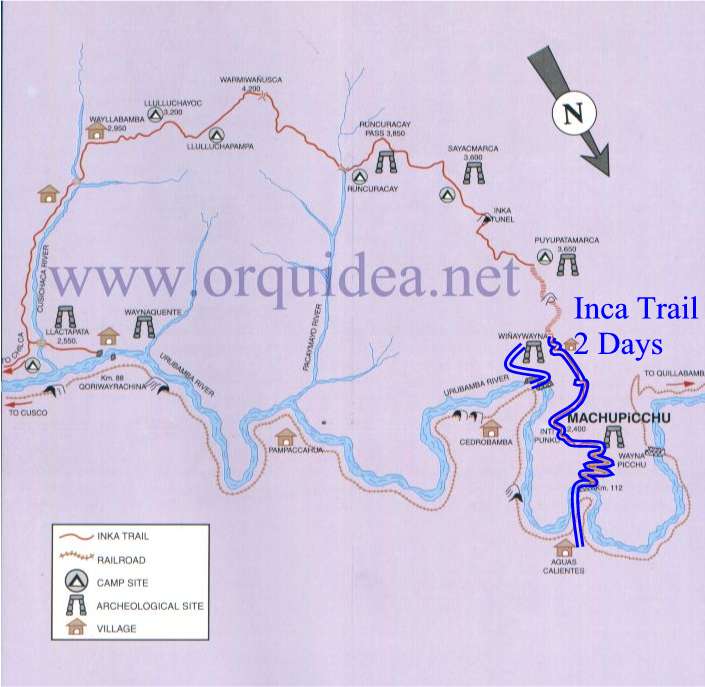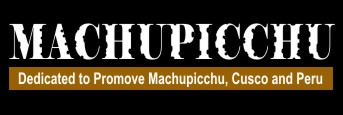|
Location: Machu Picchu is located at 120
kilometers (75 miles) North-West of Cusco city, at 2,400 meters
(7,900 ft.) above sea level. The only ways to get there is by train
(4 hours) or walking. It isn't a road from Cusco to Machu Pichu only
a railroad along the narrow Vilcanota canyon. The topography is
amazing, steep mountains covered by tropical forests, it's
incredible how the Incas built temples and trails on the slopes of
these mountains.

Climate: It's tropical, warm and sunny days and cool nights. It's
very rainy between December and March, but it's still wonderful.
Bring a rain-jacket or umbrella, and you will be fine.
Landscapes: Machu Picchu is 1,000 meters (3,300 ft.) lower than
Cusco city, that's why the environment here is different. The cloud-forest
that covers the steep mountains around the citadel is habitat of an
interesting wildlife that includes the Andean bear and the cock-of
the rock bird. The ruins and the surroundings are part of a national
park to protect the archaeological remains and the environment.
History: In the 15th century, the Incan Emperor Pachacútec built a
city in the clouds on the mountain known as Machu Picchu ("old
mountain"). This extraordinary settlement lies halfway up the Andes
Plateau, deep in the Amazon jungle and above the Urubamba River. It
was probably abandoned by the Incas because of a smallpox outbreak
and, after the Spanish defeated the Incan Empire, the city remained
'lost' for over three centuries. It was rediscovered by Hiram
Bingham in 1911. it has not stopped to surprise the world. The
archeologists believe it was built in the second half of the 15th
century, but the function of it is still a mystery. It has been
proved that many people lived there, but only important people as
noblemen, priests and nuns. After the Spanish conquest, the Incas
fled and abandoned the citadel, and nobody else heard about it, not
even the Spaniards who never got there.
Machu Picchu has two sectors; an agricultural sector and an urban
sector.
The agricultural sector consists of stepped terraces for cultivation
(andenes) built on the slopes of surrounding mountains .
The urban sector is "U" shaped and has two immense architectural
groups with streets and stairwells that consist of a total of 3,000
steps, as well as a network of water canals suitable for domestic
and irrigation use, interspersed with small squares and courtyards.
The constructions in Machu Picchu have rectangular floor spaces.
Many of the enclosures, called masmas, have only three walls, which
at one time were all thatched with tree trunks and ichu (straw).
Doors and windows are encased in trapezoid shapes as are the niches
in the walls where idols and other objects were placed; a typical
feature of Inca architecture.
Each wall in Machu Picchu is different; even those that share the
same enclosure have different styles. The best finished wall is the
main wall of the Templo Principal (Main Temple), where the cut and
polished stones are flawlessly fitted together.
Worthy of attention too are the Intihuatana, a sundial made out of
polished stone; the Torreón (Watchtower), a building with curved
walls, and the Templo de las Tres Ventanas (Temple of the Three
Windows).
Historical Sanctuary
Due to its special location in a region of Peru where the Andes and
the Amazon meet, the 32,592 hectares surrounding the citadel have
been declared a protected area in order to preserve the flora, fauna
and geological formations, as well as the archeological remains
The Machu Picchu Sanctuary is a priceless example of Andean
archeology and culture, combined with a spectacular natural
environment home to species of fauna and flora unknown elsewhere in
the world.
Apart from Machu Picchu itself, there are 34 other archeological
groups in the Sanctuary, which are interconnected by the ancient
Inca Trail, an impressive original Inca route, which nowadays is
open to tourists.
Notable amongst these sites are the Inca constructions of Runquracay,
the ruins of Sacyamarca (similar to Machu Picchu), the citadel of
Phuyupatamarca ("Town above the Clouds"), the ruins of Wiñay Wayna
("Eternally Young"), the Temple of the Moon and the archeological
group known as the Gran Caverna ("Great Cavern").
The flora of Machu Picchu is exuberant, and in higher areas
different species of high-Andean grains are found. In the low areas,
trees such as the "aliso" Alnus jorullensis, "nogal" Juglans
neotropica, "intimpa" Podocarpus glomeratus, "Kisuar" Buddleja
incana may be found. There are also 30 genus and over 90 species of
orchids.
Among the fauna of Machupicchu we can find birds such as the
"condor"
(Vultur gryphus) and diverse species of hummingbirds, and mammals
such as pumas (Felis concolor), the "tigrillo" (Felis pardalis) as
well as a few species of monkeys and ophidians of the Bothrops
species. There are species in danger of extinction in the Sanctuary
as well, such as the "rock hen"
("gallito de las rocas"), the "spectacled bear" ("oso de anteojos"),
the otter and the mountain cat.
Perhaps the main attraction of the citadel is the degree of
technology that its builders achieved in stone work. The joins
between the stones in some of its buildings are so snug that it’s
impossible to insert even the tip of a needle between them. The most
fascinating stone is the "Intihuatana"
(hitching post of the sun), which served as an astronomical
calendar.
Nevertheless, more interesting is the energy and peace you feel when
you get in this mysterious place.
More
Information
1.-
How to get There
2.- How to visit
3.- General Services
4.- Public Services
5.-
Aguas Calientes Town
6.-
Handicrafts Market
7.- Visiting rules
|
